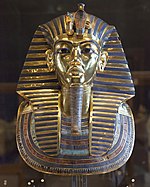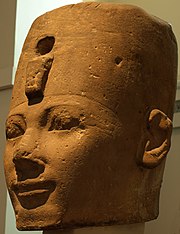Portal:Ancient Egypt
Showcased content about Ancient EgyptAncient Egypt was a civilization of ancient North Africa, concentrated along the lower reaches of the Nile River, situated in the place that is now the country Egypt. Ancient Egyptian civilization followed prehistoric Egypt and coalesced around 3100 BC (according to conventional Egyptian chronology) with the political unification of Upper and Lower Egypt under Menes (often identified with Narmer). The history of ancient Egypt occurred as a series of stable kingdoms, separated by periods of relative instability known as Intermediate Periods: the Old Kingdom of the Early Bronze Age, the Middle Kingdom of the Middle Bronze Age and the New Kingdom of the Late Bronze Age. Egypt reached the pinnacle of its power in the New Kingdom, ruling much of Nubia and a sizable portion of the Near East, after which it entered a period of slow decline. During the course of its history Egypt was invaded or conquered by a number of foreign powers, including the Hyksos, the Libyans, the Nubians, the Assyrians, the Achaemenid Persians, and the Macedonians under the command of Alexander the Great. The Greek Ptolemaic Kingdom, formed in the aftermath of Alexander's death, ruled Egypt until 30 BC, when, under Cleopatra, it fell to the Roman Empire and became a Roman province. The success of ancient Egyptian civilization came partly from its ability to adapt to the conditions of the Nile River valley for agriculture. The predictable flooding and controlled irrigation of the fertile valley produced surplus crops, which supported a more dense population, and social development and culture. With resources to spare, the administration sponsored mineral exploitation of the valley and surrounding desert regions, the early development of an independent writing system, the organization of collective construction and agricultural projects, trade with surrounding regions, and a military intended to assert Egyptian dominance. Motivating and organizing these activities was a bureaucracy of elite scribes, religious leaders, and administrators under the control of a pharaoh, who ensured the cooperation and unity of the Egyptian people in the context of an elaborate system of religious beliefs.[1] The many achievements of the ancient Egyptians include the quarrying, surveying and construction techniques that supported the building of monumental pyramids, temples, and obelisks; a system of mathematics, a practical and effective system of medicine, irrigation systems and agricultural production techniques, the first known planked boats, Egyptian faience and glass technology, new forms of literature, and the earliest known peace treaty, made with the Hittites. Ancient Egypt has left a lasting legacy. Its art and architecture were widely copied, and its antiquities carried off to far corners of the world. Its monumental ruins have inspired the imaginations of travelers and writers for centuries. A new-found respect for antiquities and excavations in the early modern period by Europeans and Egyptians led to the scientific investigation of Egyptian civilization and a greater appreciation of its cultural legacy. Selected articleThe Louvre Museum is one of the world's largest museums, the most visited art museum in the world, and a historic monument. The Egyptian antiquities department, comprising over 50,000 pieces, includes artifacts from the Nile civilizations which date from 4,000 BC to the 4th century AD. The collection, among the world's largest, overviews Egyptian life spanning ancient Egypt, the Middle Kingdom, the New Kingdom, Coptic art, and the Roman, Ptolemaic, and Byzantine periods. The department's origins lie in the royal collection, but it was augmented by Napoleon's 1798 expeditionary trip with Dominique Vivant, the future director of the Louvre. After Jean-François Champollion translated the Rosetta Stone, Charles X decreed that an Egyptian Antiquities department be created. Champollion advised the purchase of three collections, the Durand, Salt and Drovetti; these additions added 7,000 works. Growth continued via acquisitions by Auguste Mariette, founder of the Egyptian Museum in Cairo. Mariette, after excavations at Memphis, sent back crates of archaeological finds including The Seated Scribe. Selected pictureThe Great Sphinx of Giza, partially excavated, with two pyramids in the background. Did you know...
Selected biographyThutmose I (sometimes read as Thothmes, Thutmosis or Tuthmosis I) was the third Pharaoh of the 18th dynasty of Egypt. He was given the throne after the death of the previous king Amenhotep I. During his reign, he campaigned deep into the Levant and Nubia, pushing the borders of Egypt further than ever before. He also built many temples in Egypt and built a tomb for himself in the Valley of the Kings; he is the first king confirmed to have done this (though Amenhotep I may have preceded him). He was succeeded by his son Thutmose II, who in turn was succeeded by Thutmose II's sister, Hatshepsut. His reign is generally dated from 1506 to 1493 BC. Thutmose I's mummy was ultimately discovered in the Deir el-Bahri Cache above the Mortuary Temple of Hatshepsut, revealed in 1881. He had been interred along with those of other 18th and 19th dynasty leaders Ahmose I, Amenhotep I, Thutmose II, Thutmose III, Ramesses I, Seti I, Ramesses II, and Ramesses IX, as well as the 21st dynasty pharaohs Pinedjem I, Pinedjem II, and Siamun. The original coffin of Thutmose I was taken over and re-used by a later pharaoh of the 21st dynasty. The mummy of Thutmose I was thought to be lost, but Egyptologist Gaston Maspero, largely on the strength of familial resemblance to the mummies of Thutmose II and Thutmose III, believed he had found his mummy in the otherwise unlabelled mummy #5283. This identification has been supported by subsequent examinations, revealing that the embalming techniques used came from the appropriate period of time, almost certainly after that of Ahmose I and made during the course of the Eighteenth dynasty. News5th September 2018. At Lisht was discovered a rock cut tomb of an Egyptian official, dating to the 12th Dynasty. Rock-cut Tomb in a 4000-year-old Elite Cemetery Discovered 26th August 2018 An Egyptian team under the direction of Fahima El Nahas discovered several Ptolemaic tombs in the west of Alexandria. Ptolemaic rock-cut tombs discovered in Alexandria August 2018: in the tomb of the mayor of Memphis Ptahmose who dates around 1300 BC was found well preserved cheese, more than 3000 years old. [1] WikiProjectsMain topicsCategories► Kemetism Things to do
Related portalsWikimediaPortals |
- ^ James (2005), p. 8; Manuelian (1998), pp. 6–7.






